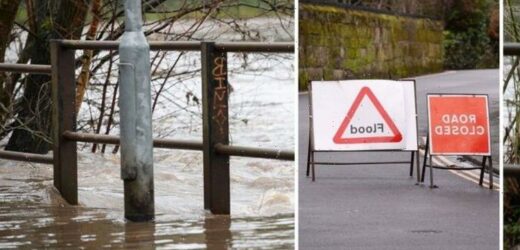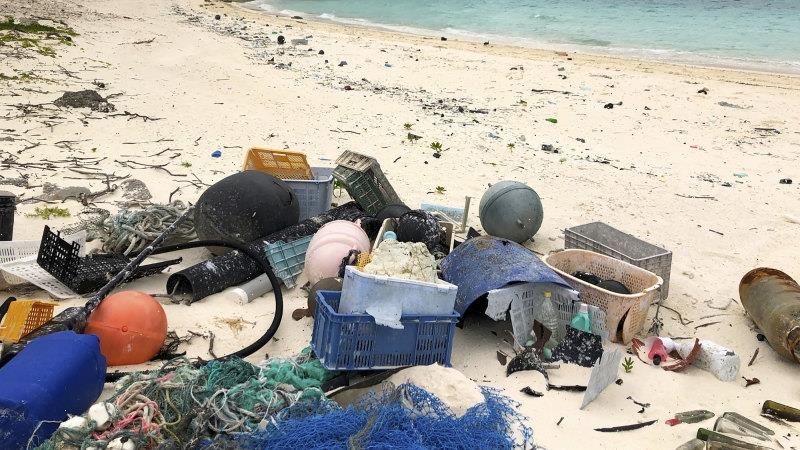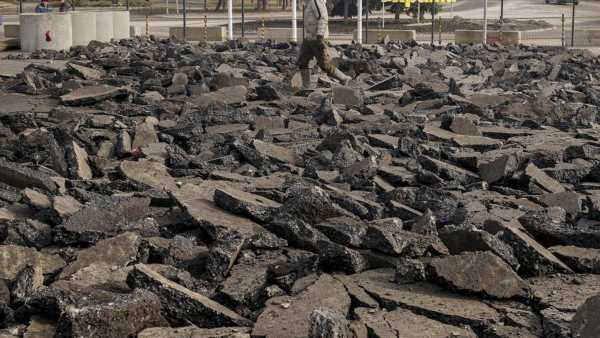Climate change: Map shows areas to be ‘below sea level’ in 2100
We use your sign-up to provide content in ways you’ve consented to and to improve our understanding of you. This may include adverts from us and 3rd parties based on our understanding. You can unsubscribe at any time. More info
Last year was the sixth-warmest year on record, something scientists attribute to climate change. Some 1.8 billion people, almost a quarter of the world’s population, live in countries that experienced their hottest year on record. La Niña, an oceanic and atmospheric phenomenon, slightly cooled global temperatures compared with what they would have been, according to NASA scientists. Despite this, many parts of the world suffered record-high temperatures as the global temperature reached 1.1℃ above the pre-industrial average.
As the planet warms, the likelihood of intense or heavy rainfall increases. Hotter air holds more moisture.
If the air has an unlimited water supply, from seas and oceans, that warmer air draws up extra moisture — so clouds contain a greater number of larger rain droplets, and can explain why summer rainfall is often heavier than in winter.
As climate change takes hold, winters will continue to become warmer and wetter, putting the UK at increased risk of flooding.
In other words, a warmer world leads to more extreme rainfall events, causing flooding.
Professor Paul Bates, one of the UK’s leading experts in the science of flooding, told Express.co.uk that many parts of the British Isles are already prone to floods.


He said: “Some of our cities along big rivers have historically flooded quite regularly. Carlisle has flooded a few times over the last 20-30 years.
“Towns along the Severn Valley, Tewksbury, Worcester, Gloucester are regularly at risk of flooding — there’s that classic photograph of Tewkesbury Abbey sat up on an island surrounded by flood water.
“And then there’s all the coastal cities. So Hull has got a big flood problem. That was hit a lot in 2007 when Tewkesbury flooded as well.
“So yeah, it’s east coast towns along there.
“London is actually quite well defended because of the Thames Barrier and also really big embankments along the Thames.”

The UK Climate Change Committee warned in 2019 that a climate change risk assessment had revealed 1.4 million people face a 1.33 percent chance of flooding in any given year.
The UKCCC warned this figure could increase to 1.7 million people if global warming reaches 2℃ above the pre-industrial level.
Climate Central has devised a map of places that would be below the tideline in different global warming scenarios (see below), ranging from 1.5℃ to 3℃.
Much of central and east London would fall below the tideline at 1.5℃, even more so at 3℃.
According to The New York Times, current policies put us on a trajectory for roughly 3℃ of warming by 2100.
DON’T MISS:
Sea level rise warning: UK maps show areas to hit by major flood risk [INSIGHT]
23 Football stadiums at risk of flooding in 30 years – is your team’s? [REVEALED]
How much could Boris Johnson net zero strategy cost you? [INSIGHT]

As Prof Bates explained, much of the east coast would be affected, as would several towns and cities along the south coast and up the Severn Estuary.
Scientists said, prior to the COP26 summit, that this would be limited to between 2 and 2.4℃ if countries stick to their promises to slash emissions faster.
However, they also warned that even this is too risky. Far more drastic action is needed to limit global temperature rise to a much safer level of 1.5℃.
Prof Bates admitted that the “damage is done” when it comes to sea level rise, and it will continue for centuries.
He explained: “Even if we decarbonise very quickly and greenhouse gases start to come down, sea levels will continue to rise for centuries still as the ocean continues to warm up and ice sheets start to discharge more of their ice into the oceans.”

Met Office data estimates that London’s sea levels will increase by between 29cm and 70cm by 2100.
This figure could increase significantly in the centuries to come as the oceans store an enormous amount of heat.
Prof Bates said that a lot of the uncertainty over future sea levels depends on how the ice sheets behave.
He said: “We don’t know as much as we’d like to about how the ice sheets behave.
“So if West Antarctica were to seriously start melting, that might lead to really quite extreme levels of sea level rise in the UK.”
He explained that, under current projections, sea levels will have risen by a metre by 2300 and “if ice sheets collapse, it could be several metres”.
Though sea level rise is inevitable now, it can also be controlled to an extent.
Climate and energy choices made in the short-term will have a sizable impact on the longer term future.
Likewise, the timing of these sea level rises can be very difficult to predict.
The figures at the upper end of the scale can be especially unpredictable given the unknown behaviour of the ice sheets, and the measures humans can take between now and then.
Source: Read Full Article


